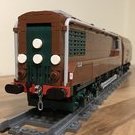Sign in to follow this
Followers
0

[Digi=MOC] - Plasser & Theurer RM900-RT
By
Hod Carrier, in LEGO Train Tech
-
Recently Browsing 0 members
No registered users viewing this page.
